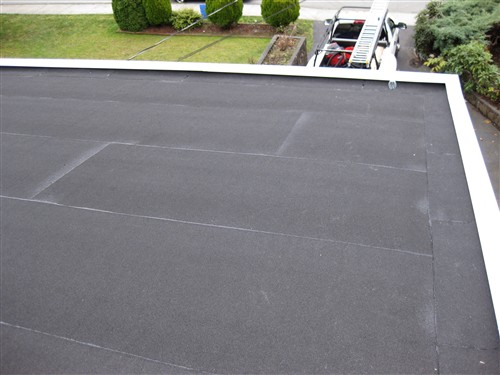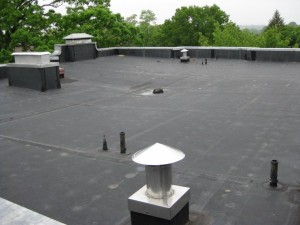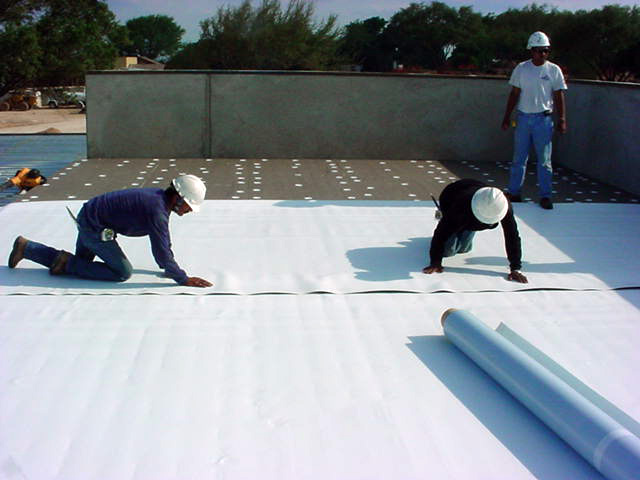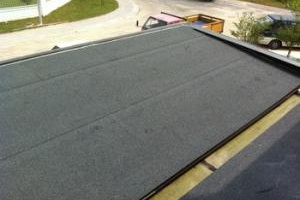Benefits of Flat Roof Construction:
There is a common misconception among many home-improvement contractors and residential builders / architects that flat roofs = problems. The truth is that flat roofs are very convenient, easier to build, and cost less than pitched / sloped roofs. In some cases, a flat roof is the only way to go, for example, when you have a large size building. Building a reliable pitched roof in those cases will require extra engineering to accommodate for additional structural weight.
Flat roofs are also convenient for installing large HVAC equipment that otherwise would have to be installed on the ground. You can also use flat roof as a roof-top deck, patio or penthouse. Green roofs are also gaining popularity with environmentally conscious companies and organizations.
When you compare all the construction costs and environmental benefits, flat roofs by far surpass any sloped roof, for which the roof products of choice are oil-based asphalt shingles. These asphalt shingles end up in our land-fills every 12-15 years, and yet more and more of them are produced.
 Rubber Modified Bitumen
Rubber Modified Bitumen
“Modified bitumen” might be an unfamiliar term to many people who aren’t in the roofing industry, but it is a common choice in commercial roofing and other flat or nearly-flat roofs. Bitumen is also known as asphalt, which has been used in roofing for over 100 years. In the 1960s, modified bitumen was developed in order to create a roofing material that has all the physical properties of asphalt along with additional flexibility and weathering benefits of plastic or rubber.
Before modified bitumen roofing came along, it was common for large flat-roofed buildings to have a heavy coating of gravel as part of the built-up roof (BUR) system. The gravel coating serves the dual purpose of protecting the asphalt from UV rays while weighing it down. Modified bitumen membranes are able to expand and contract with the rest of the roofing layers, and because they adhere directly to the substrate they do not need to be covered with gravel, although they do still need a UV-protective coating. Aside from putting much less weight on the structure, the lack of a heavy gravel or ballast cover can make it easier to find leaks.
 EPDM
EPDM
 TPO Roofing
TPO Roofing
Thermoplastic polyolefin (TPO) single-ply roofing membranes are among the fastest growing commercial roofing products and have gained broad industry acceptance for their many performance and installation advantages. As demand increases for heat-reflective and energy efficient roofing systems, TPO single-ply roofing membranes continue to provide exceptional resistance to ultraviolet, ozone and chemical exposure.
 Asphalt Roll Roofing
Asphalt Roll Roofing
Rolled roofing is essentials the same material as asphalt shingles, but thinner and it is installed in long strips. Several types of roll roofing are used as supplements to other roofing materials such as saturated felt. This is builders-grade felt impregnated with asphalt, and is used mainly as underlayment. Rolled roofing is used on roofs that are low-sloped. If your roof pitch declines 2 inches or less vertically per 12 feet horizontally, it is a candidate for roll roofing. Rolled roofing is also used on roofs where aesthetics aren’t much of a consideration, such as work sheds, garages, and out-buildings.
Resurface Repair
If your low slope roof is showing its age, but just isn’t ready for replacement, American Homes Specialists, can extend the life of your roof by resurfacing and repairing your roof with durable materials. AHS uses the latest materials and can apply a rolled on coating or a foam coating to your aging roof. A timely repair can spare your roof from further damage.



